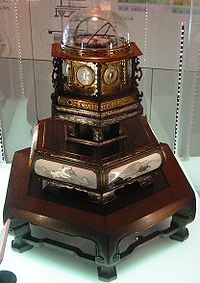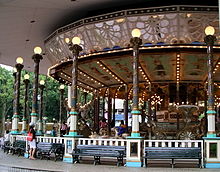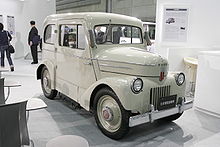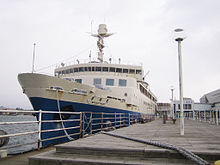- Mechanical Engineering Heritage (Japan)
-
The Mechanical Engineering Heritage (Japan) (機械遺産 kikaiisan) is a list of sites, landmarks, machines, and documents that made significant contributions to the development of mechanical engineering in Japan. Items in the list are certified by the Japan Society of Mechanical Engineers (JSME) (日本機械学会 Nihon Kikai Gakkai).
Contents
Overview
The Mechanical Engineering Heritage program was inaugurated in June 2007 in connection with the 110th anniversary of the founding of the JSME. The program recognizes machines, related systems, factories, specification documents, textbooks, and other items that had a significant impact on the development of mechanical engineering. When a certified item can no longer be maintained by its current owner, the JSME acts to prevent its loss by arranging a transfer to the National Science Museum of Japan or to a local government institution.
The JSME plans to certify approximately a hundred items of high heritage value over ten years.
Categories
Items in the Mechanical Engineering Heritage (Japan) are classified into four categories:
- Sites: Historical sites that contain heritage items.
- Landmarks: Representative buildings, structures, and machinery.
- Collections: Collections of machinery, or individual machines.
- Documents: Machinery-related documents of historical significance.
Each item is assigned a Mechanical Engineering Heritage number.
Items certified in 2007
Sites
- No. 1: Steam engines and hauling machinery at the Kosuge Ship Repair Dock, (built in 1868). - Nagasaki Prefecture
Landmarks
- No. 2: Memorial workshop and machine tools at Kumamoto University, (built in 1908). - Kumamoto Prefecture
Collections
- No. 3: Forged iron treadle lathe (made in 1875 by Kaheiji Ito). - Aichi Prefecture
- No. 4: Industrial steam turbine (Parsons steam turbine), (made in 1908). - Nagasaki Prefecture
- No. 5: 10A rotary engine (made in 1967). - Hiroshima Prefecture
- No. 6: Honda CVCC engine (first engine to meet emission standards of Clean Air Act (1970)). - Tochigi Prefecture
- No. 7: FJR710 jet engine (made in 1971). - Tokyo
- No. 8: Yanmar small horizontal diesel engine, Model HB (made in 1933). - Shiga Prefecture
- No. 9: Prof. Inokuchi's centrifugal pump, (made in 1912). - Aichi Prefecture
- No. 10: High frequency generator (made in 1929 by German AEG). - Aichi Prefecture
- No. 11: 0-Series Tōkaidō Shinkansen electric multiple units (operated 1964–1978). - Osaka Prefecture
- No. 12: Class 230 No.233 2-4-2 steam tank locomotive (made 1902–1909). - Osaka Prefecture
- No. 13: YS11 passenger airplane (flown 1964–2009). - Tokyo
- No. 14: Cub Type F, Honda bicycle engine (1952). - Tochigi Prefecture
- No. 15: Chain stitch sewing machine for the production of straw hats (made in 1928). - Aichi Prefecture
- No. 16: Non-stop shuttle change automatic loom, Toyoda Type G (made in 1924). - Aichi Prefecture
- No. 17: Hand operated letterpress printing machine (made in 1885). - Tokyo
- No. 18: Komatsu bulldozer G40 (made in 1943). - Shizuoka Prefecture
- No. 19: Olympus gastrocamera GT-I (made in 1950). - Tokyo
- No. 20: Buckton[1] universal testing machine (installed in 1908). - Hyōgo Prefecture
- No. 21: Mutoh Drafter manual drafting machine, MH-I (made in 1953). - Tokyo
- No. 22: Myriad year clock, (made in 1851). - Tokyo
- No. 23: The Chikugo River Lift Bridge (opened in 1935). - Between Fukuoka and Saga Prefecture
Documents
- No. 24: JSME publications from the early days of the society, (published in 1897, 1901 and 1934). - Tokyo
- No. 25: "Hydraulics and Hydraulic Machinery", lecture notes by Professors Bunji Mano and Ariya Inokuchi at Imperial University of Tokyo (1905). - Tokyo
Items certified in 2008
Sites
- No. 26: Sankyozawa hydroelectric power station and related objects, (operating since 1888). - Miyagi Prefecture
- No. 27: Hydraulic lock (made in United Kingdom, operating since 1908) and floating steam crane (operated 1905–2008), Miike Port. - Fukuoka Prefecture
Collections
- No. 28: “Entaro” bus (Ford TT type), (1923, adapted from chassis imported from United States). - Saitama Prefecture
- No. 29: Mechanical telecommunication devices (made in 1947 by Shinko Seisakusho Co.). - Iwate Prefecture
- No. 30: Mechanical calculator, (Yazu Arithmometer, patented in 1903). - Fukuoka Prefecture[2]
- No. 31: Induction motor and design sheet (made in 1910, in the earliest days of the Japanese electrical machinery industry). - Ibaraki Prefecture
Items certified in 2009
Sites
- No. 32: Mechanical Device of Sapporo Clock Tower, (clock mechanism imported/installed from E. Howard & Co. in 1881, moved in 1906). - Hokkaidō
Landmarks
- No. 33: Minegishi Watermill, (installed in 1808, in operation till 1965). - Tokyo
Collections
- No. 34: The Master Worm Wheel of the Hobbing Machine HRS-500, (machining by Hobbing machine of Rhein-Neckar from Germany in 1943). - Shizuoka Prefecture
- No. 35: Locomobile, The oldest private Steam Automobile in Japan, (one of eight imported from Locomobile Company of America in 1902, failured in 1908, discovered in 1978 then only boiler was replaced and operable in 1980). - Hokkaidō
- No. 36: Arrow-Gou, The oldest Japanese-made Car, (one of Japanese fundamental vehicle technology made in 1916). - Fukuoka Prefecture
- No. 37: British-made 50 ft Turn Table, (imported from Ransomes & Rapier made in 1897, but installed location was unknown before moved in 1941 then further moved to Ōigawa Railway in 1980, in operation. Two others are deemed also imported and still in operation in other locations, these historical details is not known). - Shizuoka Prefecture
Items certified in 2010
Landmarks
- NO. 38: Carousel El Dorado of Toshimaen, the oldest in Japan and oldest class in worldwide, produced by Hugo Haase (German, 1857-1933) in 1907, travelled in Europe, then moved to Steeplechase Park of Coney Island, New York in 1911, operated till 1964, then purchased, refurbished and operate in Toshimaen since 1971. - Tokyo[3][4]
- No. 39: Revolving stage and its slewing mechanism of old Konpira Grand Theatre. - Kagawa Prefecture
Collections
- No. 40: Electric vehicle TAMA (E4S-47 I), produced by Tachikawa Aircraft Company Ltd in 1947, to overcome oil shortage after World War II. The car is with single motor of 36V, 120A, run 65km by single charge, max. speed 35km/h. The second model in 1949 run 200km. Used as taxi in Tokyo. Production had quitted due to cost up of battery by Korean War. - Kanagawa Prefecture
- No. 41: The first made in Japan forklift truck with internal combustion engine, max. load 6,000 pound, in 1949, learned from Clark Material Handling Company's 4,000 pound type. - Shiga Prefecture
- No. 42: Takasago and Ebara type Centrifugal Refrigerating machine. - Kanagawa Prefecture
- No. 43: Automated Ticket Gate (Turnstile), OMRON and Kintetsu jointly studied from 1964, model PG-D120 operated from 1973 after prototype evaluation from 1967. - Kyoto Prefecture
Items certified in 2011
Landmarks
- NO. 44: Seikan Train Ferry and Moving Rail Bridge. The ferry service started between Aomori Station of Honshu and Hakodate Station of Hokkaido in 1908, and became train ferry service from 1925 till Seikan Tunnel operated in 1988. Landmark is both Hakkoda Maru ( 八甲田丸) and moving rail bridge at Aomori Station, and Mashū Maru (摩周丸) and moving rail bridge at Hakodate Station. - Aomori Prefecture and Hokkaidō
Collections
- NO. 45: Type ED15 Electric Locomotive. This direct current locomotive is the first Japan made one in 1924 and operation till 1960. It is functionally equal to imported electric locomotive with specification of maximum speed 65 km/h with 820 KW by four main motors. - Ibaraki Prefecture
- NO. 46: Silk reeling machines of the Okaya Silk Museum (岡谷蚕糸博物館), several types of silk reeling machines. Machines are; 2 silk reeling machines out of 300 machines imported by French engineer Paul Brunat (ポール・ブリューナ) for Tomioka silk mill which operated from 1872, Japan made machine based on French and Italian technologies, and some other Japan made improved and innovated machines. - Nagano Prefecture
- NO. 47: Toyoda Power Loom. Looms power by steam engine type and electric motor types invented by Sakichi Toyoda in 1897 and patented next year. Machine's productivity is 20 times high and 1/20 of low in machine cost compared to imported machines, widely used through out Japan. - Aichi Prefecture
- NO. 48: Hydraulic Excavator UH03 is the first evolved type, made in Japan in 1965, having double hydraulic pumps and double valves with bucket size 0.35 m³ and engine output 58 hp. The excavators made in Japan before UH03 are single hydraulic pump and single valve type under technical tieb up with Europe. - Ibaraki Prefecture
- NO. 49: Zipper chain machine (YKK-CM6) is YKK Group first made in Japan machine in 1953, evolved from imported machine from U.S. in 1950. - Toyama Prefecture
- NO. 50: Ticket Vending Machine is the first train ticket vending machine consisted by 250 piece of relay, developed in 1962. This machine is capable to print various train fee per destination on a roll paper and cut as a ticket, to accepts Japanese coin and sorting then storage, returns change and detects fake coins. The improved type made in 1969 was installed in Bankokuhaku-chūōguchi station (万国博中央口駅) of Expo '70 in Suita, Osaka. - Nagano Prefecture
See also
References
- ^ Buckton machine:See fig.3 and its description.
- ^ The History of Japanese Mechanical Calculating Machines
- ^ "Collections: American Art: Lion, from the El Dorado Carousel, Coney Island, Brooklyn". Brooklyn Museum. http://www.brooklynmuseum.org/opencollection/objects/90656/Lion_from_the_El_Dorado_Carousel_Coney_Island_Brooklyn. Retrieved 2010-07-26.
- ^ The carousel King, Hugo Haase
External links
- The Japan Society of Mechanical Engineers, JSME
- The Mechanical Engineering Heritage (Japan) list — official website, in Japanese with English titles
Categories:- 2007 establishments in Japan
- Archives in Japan
- Mechanical engineering
- History of engineering
- History of Japan
- Japanese culture
- Science and technology in Japan
Wikimedia Foundation. 2010.




